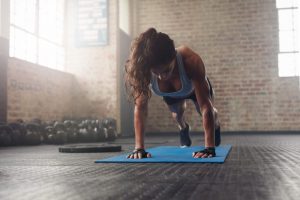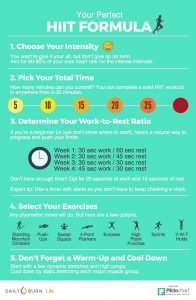by: Malia Kaaiohelo
Do you find yourself not having enough time to work out? Does the goal of losing weight and getting in shape feel unattainable? Are you looking for some intense workout other than running or weightlifting? What if I told you there was a type of training that you can do in a 30-minute window that offers you benefits like decreased risk of CVD, Blood Pressure, and increased aerobic capacity? This can all be acquired through High Intensity Interval Training or HIIT for short.
THE GOAL OF H.I.I.T.
HIIT aims to have the client reach 80-95% of his or her maximum heart rate in short bouts of high intensity exercises followed by a limited amount of rest. The workout to rest ratio can usually be seen at 20:40 seconds (Falcone et. Al, 2015) or for every second you work at a high intensity, take two seconds of rest. This means that you spend more time resting than working out! However, the shorter the rest period, the shorter amount of time the whole workout takes. Some people can finish a workout in almost 10 minutes if they really push through the exercises. Do you still not feel convinced? Well let’s take some time to look at the many benefits one can receive through HIIT.
BENEFITS
HIIT is still going to be a challenge, but the workout can be worth it when you are aware of how it is benefitting your body. Here are some things that can improve while you are sweating through a HIIT workout:
- Improved blood pressure
- Decreased abdominal and subcutaneous fat
- Enhanced weight loss
- Increased skeletal muscle fat oxidation
- Improved aerobic and anaerobic fitness (VO2 max)
- Increased exercise adherence
- Decreased risk of cardiovascular disease (Falcone et. Al, 2015)
Now I know what you may be thinking. “Can’t I receive all of these benefits with any type of physical activity?”. Let’s look at the benefits specifically known to HIIT compared to completing 30 minutes of other modes of exercise (Roy):
- HIIT burns 20-30% more calories than other forms of exercise
- Metabolic rate is much higher for several hours after the workout is done
- The body shifts to burning more fat rather than carbs
- HIIT can be beneficial for those who are at risk for type 2 diabetes and improve blood sugar for those who have type 2 diabetes
HOW TO GET STARTED
It is recommended that you get a health screening done before you attempt any high intensity interval training while being at risk from conditions such as diabetes, obesity, old age, etc. After that, the next step is simple. Find a mode of exercise you are comfortable performing. It could be cycling, sprinting, swimming, rowing, boxing, jump roping, or any other kind of similar activity.
Begin with a 5-10 minute warm up, then take the activity you’ve chosen and provide a workout/rest period ratio. For example, if you’re jump roping you could jump for 30 seconds and rest 30 seconds, jump 20 seconds and rest 40 seconds, or jump 40 seconds and rest 20 seconds. After you’ve chosen your ratio, you could repeat that for however minutes you choose. Just make sure in the seconds you choose to workout you’re going as hard as you can. You could even switch up workouts, so you aren’t completing the same activity the whole workout. That’s the exciting part. You can make the workout entirely your own! You can add weights, equipment, bands, etc. Who said you couldn’t enjoy getting in shape?
EXAMPLES OF HIIT WORKOUTS
- Cycle as hard as you can for 30 seconds, rest for 30 seconds (Repeat for 10 minutes)
- 3 rounds (40 second work, 20 second rest): push-ups, squats, butt kicks, side lunges
- 10 med ball slams, 5 box jumps, 50 jump ropes, 30 second plank (See how many rounds you can get through in a 15-minute period. Rest as much as needed;(Creveling, 2017)
CONCLUSION
High Intensity Interval Training has been up and coming the past few years, so it is fairly new information for those who have only tried traditional modes of exercise. However, the newfound benefits are very exciting and very applicable to all categories of people. As long as you know you’re pushing yourself, you’re going to feel better and start to look better. With just two sessions a week, you can stimulate physiologic adaptations that will leave you healthier than before. What are you waiting for? HIIT the gym!
WORK CITED
Creveling, Mallory. “Design Your Own HIIT Workout with This Perfect Formula.” Dailyburn, 2017, dailyburn.com/life/wp-content/uploads/2017/04/HIIT-Formula-Infographic-1.jpg.
Falcone, P. H., Tai, C. Y., Carson, L. R., Joy, J. M., Mosman, M. M., McCann, T. R., Crona, K. P., Kim, M. P., & Moon, J. R. (2015). Caloric expenditure of aerobic, resistance, or combined high-intensity interval training using a hydraulic resistance system in healthy men. Journal of strength and conditioning research, 29(3), 779–785. https://doi.org/10.1519/JSC.0000000000000661
Roy, Brad A. “High-Intensity Interval Training: Efficient, Effective,… : ACSM’s Health & Fitness Journal.” LWW, journals.lww.com/acsm-healthfitness/Fulltext/2013/05000/High_Intensity_Interval_Training___Efficient,.3.aspx.

